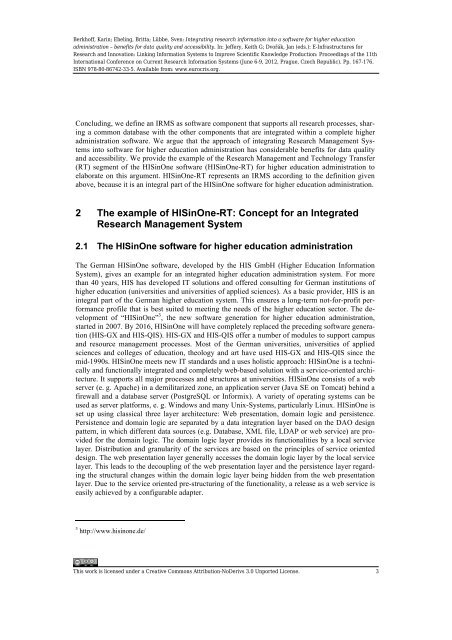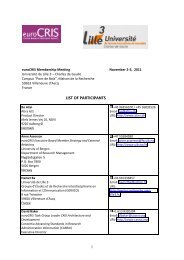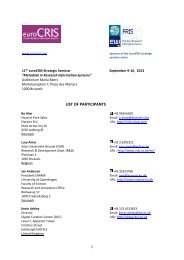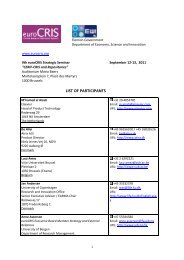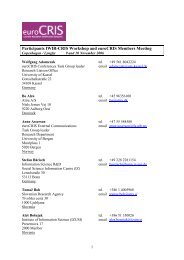Paper - EuroCRIS
Paper - EuroCRIS
Paper - EuroCRIS
Create successful ePaper yourself
Turn your PDF publications into a flip-book with our unique Google optimized e-Paper software.
Berkhoff, Karin; Ebeling, Britta; Lübbe, Sven: Integrating research information into a software for higher education<br />
administration – benefits for data quality and accessibility. In: Jeffery, Keith G; Dvořák, Jan (eds.): E-Infrastructures for<br />
Research and Innovation: Linking Information Systems to Improve Scientific Knowledge Production: Proceedings of the 11th<br />
International Conference on Current Research Information Systems (June 6-9, 2012, Prague, Czech Republic). Pp. 167-176.<br />
ISBN 978-80-86742-33-5. Available from: www.eurocris.org.<br />
Concluding, we define an IRMS as software component that supports all research processes, sharing<br />
a common database with the other components that are integrated within a complete higher<br />
administration software. We argue that the approach of integrating Research Management Systems<br />
into software for higher education administration has considerable benefits for data quality<br />
and accessibility. We provide the example of the Research Management and Technology Transfer<br />
(RT) segment of the HISinOne software (HISinOne-RT) for higher education administration to<br />
elaborate on this argument. HISinOne-RT represents an IRMS according to the definition given<br />
above, because it is an integral part of the HISinOne software for higher education administration.<br />
2 The example of HISinOne-RT: Concept for an Integrated<br />
Research Management System<br />
2.1 The HISinOne software for higher education administration<br />
The German HISinOne software, developed by the HIS GmbH (Higher Education Information<br />
System), gives an example for an integrated higher education administration system. For more<br />
than 40 years, HIS has developed IT solutions and offered consulting for German institutions of<br />
higher education (universities and universities of applied sciences). As a basic provider, HIS is an<br />
integral part of the German higher education system. This ensures a long-term not-for-profit performance<br />
profile that is best suited to meeting the needs of the higher education sector. The development<br />
of “HISinOne” 3 , the new software generation for higher education administration,<br />
started in 2007. By 2016, HISinOne will have completely replaced the preceding software generation<br />
(HIS-GX and HIS-QIS). HIS-GX and HIS-QIS offer a number of modules to support campus<br />
and resource management processes. Most of the German universities, universities of applied<br />
sciences and colleges of education, theology and art have used HIS-GX and HIS-QIS since the<br />
mid-1990s. HISinOne meets new IT standards and a uses holistic approach: HISinOne is a technically<br />
and functionally integrated and completely web-based solution with a service-oriented architecture.<br />
It supports all major processes and structures at universities. HISinOne consists of a web<br />
server (e. g. Apache) in a demilitarized zone, an application server (Java SE on Tomcat) behind a<br />
firewall and a database server (PostgreSQL or Informix). A variety of operating systems can be<br />
used as server platforms, e. g. Windows and many Unix-Systems, particularly Linux. HISinOne is<br />
set up using classical three layer architecture: Web presentation, domain logic and persistence.<br />
Persistence and domain logic are separated by a data integration layer based on the DAO design<br />
pattern, in which different data sources (e.g. Database, XML file, LDAP or web service) are provided<br />
for the domain logic. The domain logic layer provides its functionalities by a local service<br />
layer. Distribution and granularity of the services are based on the principles of service oriented<br />
design. The web presentation layer generally accesses the domain logic layer by the local service<br />
layer. This leads to the decoupling of the web presentation layer and the persistence layer regarding<br />
the structural changes within the domain logic layer being hidden from the web presentation<br />
layer. Due to the service oriented pre-structuring of the functionality, a release as a web service is<br />
easily achieved by a configurable adapter.<br />
3 http://www.hisinone.de/<br />
This work is licensed under a Creative Commons Attribution-NoDerivs 3.0 Unported License. 3


